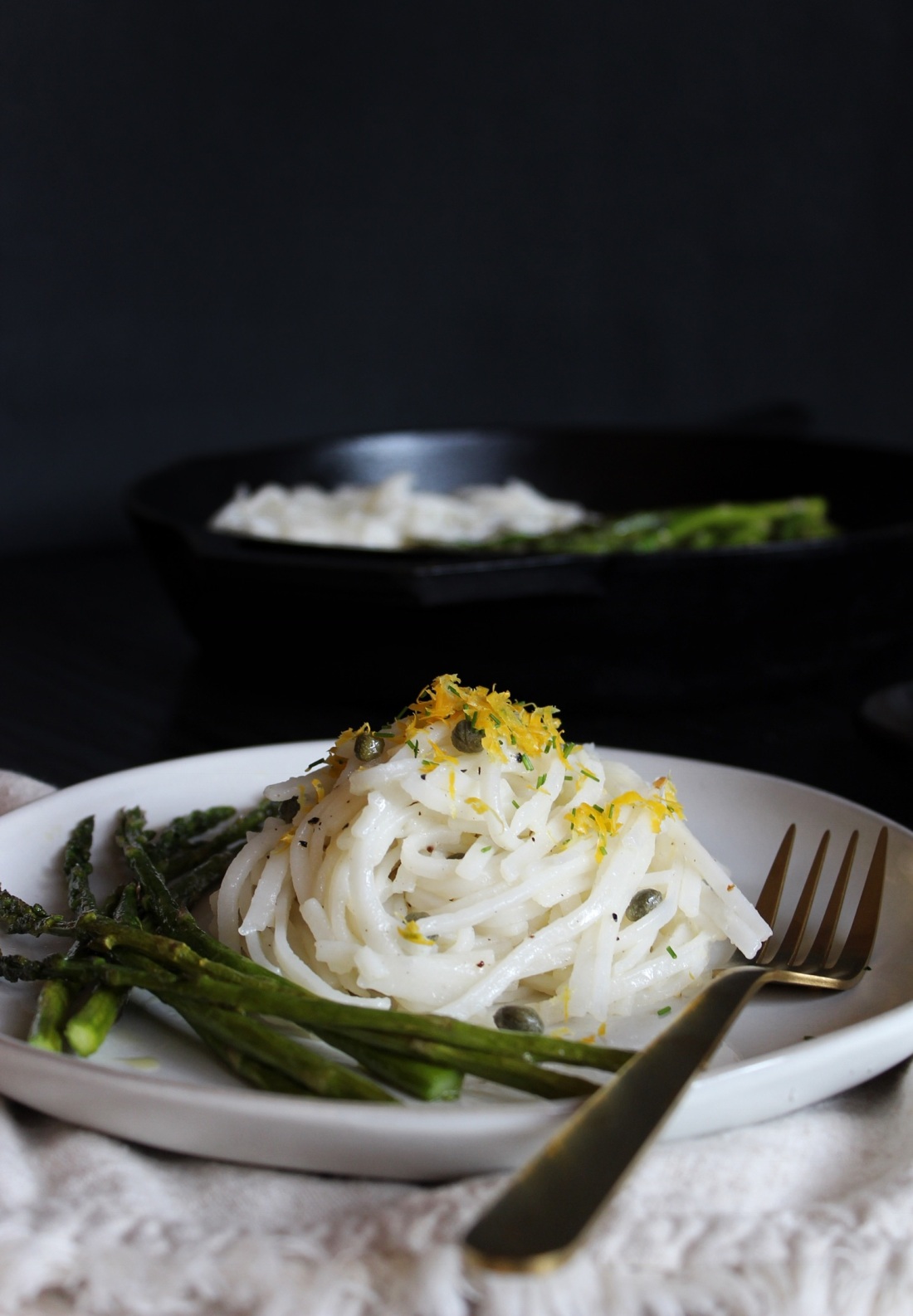Hey guys!
We hope you treated the holidays well and soaked up every hug, kiss, and fork-full of food you experienced.

One thing’s for sure though, after the Holidays, I no longer feel like rolling out pie crusts, prepping mountains of veggies, or crafting any sort of fancy fare. No, I think a plate of pasta – dressed simply with lemon juice, capers, & extra virgin olive oil – will satisfy my tastebuds, soul, and simplistic yearnings.
Truthfully, dinner doesn’t get much simpler than this. All you gotta do is boil some pasta, drain that pasta, roast asparagus, toss your pasta with seasonings, and plate it. Prep & cook time equals out to only 30 minutes… it’s a goddamn Christmas miracle.

For you curious Nancies out there, the pasta used in this recipe is flat white rice noodles a.k.a. Pad Thai noodles. I know our blog reaches many of you who don’t eat any type of rice, but here’s my take on the matter:
When you strip away the hull and bran that incases brown rice, the white rice that’s left behind is a lectin-free food. However, because most of the nutrients lie in the bran and hull (albeit, the body is unable to absorb them), white rice doesn’t contain many nutrients, which is why many forbid it from there diet. But let’s not forget that the starches in white rice & white rice products – like this pasta – can be altered into resistant starches by refrigerating them, then reheating them again for enjoyment sake.

To add to matters, I don’t have the funds to sit around and eat avocados all day, which is why I so often resort to my lectin-free variations of rice & beans as my staple meal. When I break it down, white rice – when prepared properly – is comparable to sweet potatoes, only with less nutrients, which is fine by me, because every meal doesn’t have to be packed with antioxidants, a thousand nutrients, and omega-3 fatty acids.
If you’re still curious or skeptical however, you can read this post about the differences between brown & white rice and what makes white rice an acceptable food for myself.
All in all, this is a is simple, subtly flavored, and Italian-styled pasta for two. If you like what your taste buds are tellin’ ya, leave behind a nice rating, share your thoughts with us in the comments, or show us your creations by tagging @noeggsorham on Instagram.
Cheers!
Ryan & Kim

Lemon Caper Pasta
Al-dente white rice pasta is sparked with lemon juice, surprises of salty capers, and fruity extra virgin olive oil.
Ingredients
- 14 oz flat white rice noodles (Pad Thai Style)
- large handful of asparagus spears
- 3-4 tbsp extra virgin olive oil + more for coating
- 2 tbsp capers, drained
- 1 tbsp lemon juice, freshly squeezed
- zest of one lemon, finely grated
- 1 tsp fresh chives, finely chopped
- salt
- freshly cracked black pepper
Directions
- Pre-heat oven to 450° F. Cut off bottom quarters of asparagus spears then discard them. Cut remaining spears into thirds, toss them with a heavy pinch of salt & enough olive oil to coat.
- Lay out on a baking sheet and place in pre-heated oven until tender & lightly browned; about 7 minutes.
- Cook pasta in a large pot of salted water according to package’s instructions. For mine that meant boiling it over medium-high heat for 8-10 minutes, or until it’s al-dente.
- Drain into a colander and rinse thoroughly with warm water.
- Rinse out the pot and place it back over medium heat. Add in pasta, 3 tbsp of olive oil, capers, lemon juice, lemon zest, a few grinds of black pepper, and a very heavy pinch of salt. Stir gently to combine and heat throughly – I find that chopsticks or a pasta fork work best for not destroying the noodles.
- Taste and adjust for seasoning – adding more olive oil for silkiness & moisture, salt for saltiness, pepper for bite, and lemon juice for tang.
- Plate while hot and top with roasted asparagus or stir asparagus directly into the pasta in the above step and then plate. Store leftovers in an airtight container in the fridge for up to three days. Reheat in a medium pan over medium heat with a little extra olive oil until hot.
*For resistant starch pasta – cook your pasta until it’s tender yet slightly firmer than what you’d normally enjoy, drain it thoroughly, then place it in the fridge for at least 6 hours. Then, when you’re ready to eat, transfer the pasta back into a colander, rinse with hot water, and start at Step 5.

Looks light and tasty.
LikeLike
Looks amazing! So simple to make as well (:
LikeLike